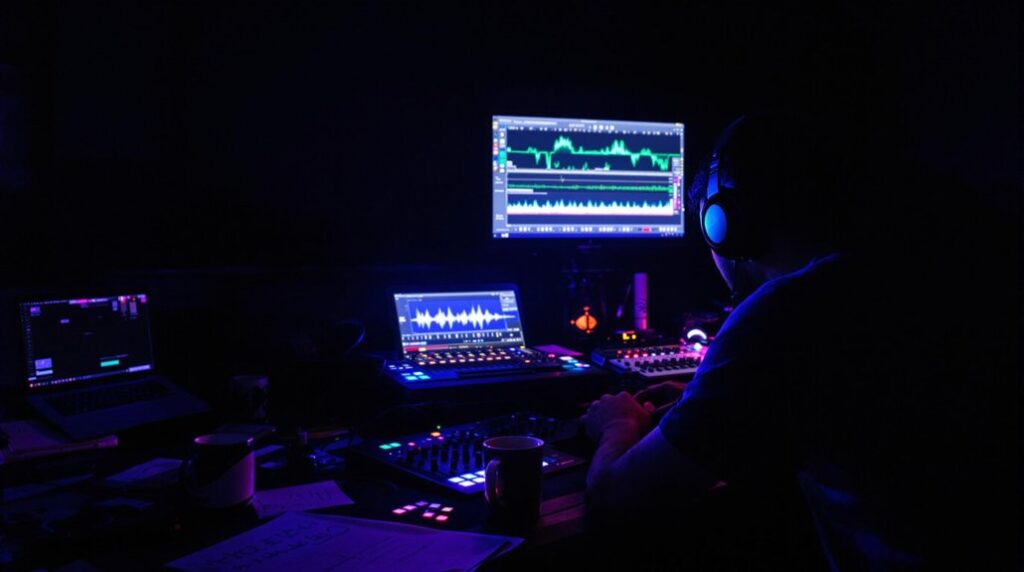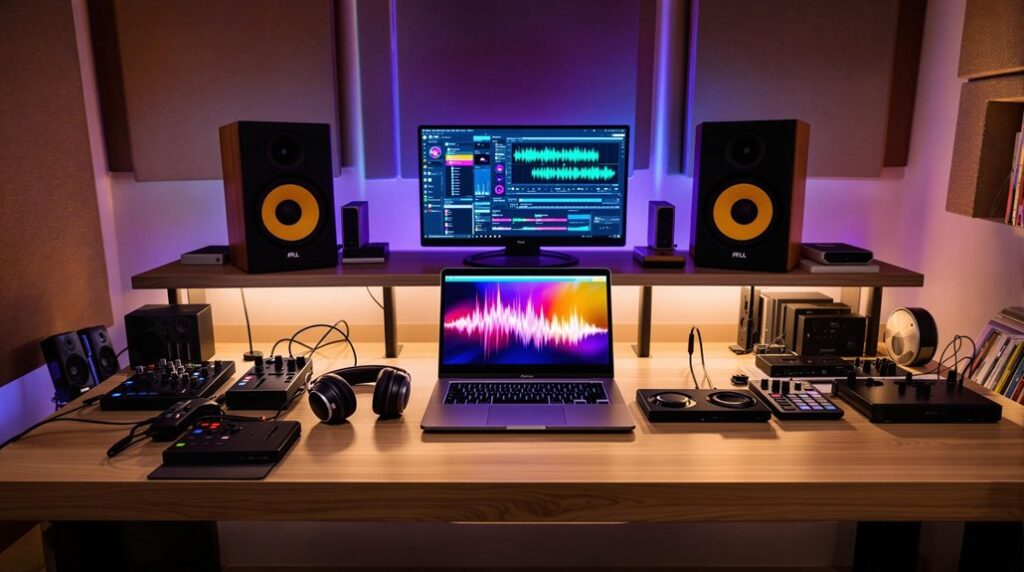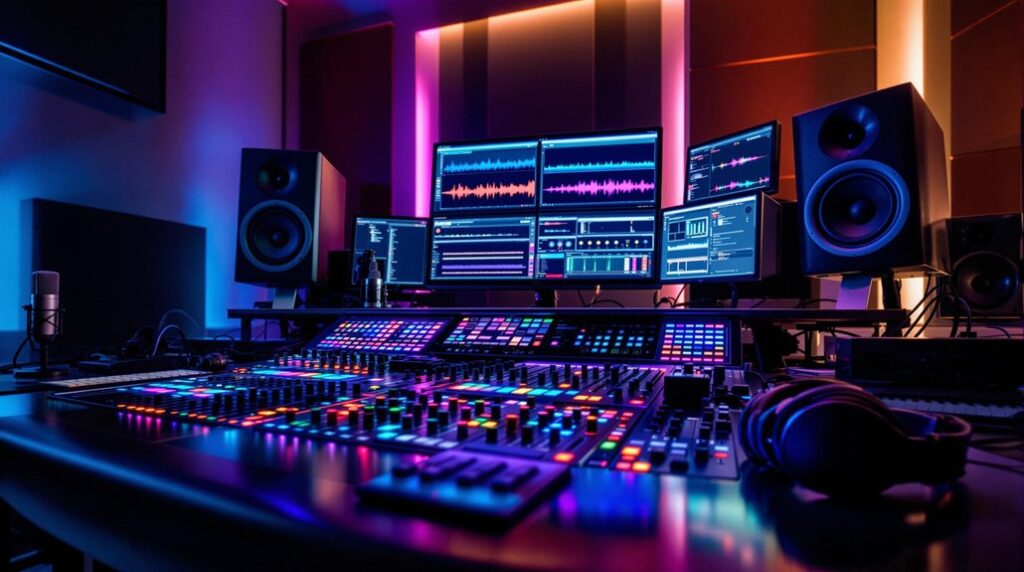Gain staging is vital in audio mixing because it guarantees an ideal signal-to-noise ratio and preserves audio quality. You’ll need to adjust input gain to prevent clipping and distortion, maintaining headroom for dynamics and mastering. By keeping levels between -12 and -18 dBFS, you avoid overloading any chain components, which keeps your mix transparent and balanced. Regularly monitor meters to visualize and correct levels effectively. Implementing noise reduction techniques will minimize the impact of the noise floor on your recordings. With these practices, you can enhance audio clarity and utilize advanced mixing techniques to their fullest potential.
Key Takeaways
- Ensures optimal signal-to-noise ratio, enhancing the clarity and quality of the audio.
- Prevents clipping and distortion, maintaining audio integrity throughout the signal chain.
- Provides ample headroom for mastering adjustments and dynamic range management.
- Balances input and output levels across all stages, creating a cohesive mix.
- Utilizes metering tools to visualize and maintain ideal audio levels, ensuring consistency.
What Is Gain Staging
Gain staging is the meticulous process of adjusting audio levels at various points in the recording and mixing chain to maintain an ideal signal-to-noise ratio and prevent distortion. You need to pay close attention to gain structure, which refers to the organization and optimization of gain levels from input to output. This guarantees each stage of your signal path is set correctly, avoiding unwanted noise and distortion.
Proper level optimization is essential. You want to adjust the input gain so the signal is strong enough to be clear but not so high that it clips. Clipping occurs when the signal exceeds the maximum level that the system can handle, resulting in distortion. By maintaining an ideal gain structure, you make sure that each component in your signal chain—from microphones to preamps to digital converters—operates within its best performance range.
Achieving effective gain staging helps you preserve the audio quality and dynamic range. It allows for better control over the volume relationships between different elements in your mix, leading to a more balanced and professional-sounding final product. Consistent gain staging throughout your project is essential for maintaining clarity, balance, and dynamics.
Key Audio Terms Explained
Understanding key audio terms is essential for mastering the craft of audio mixing and achieving professional results. Let’s break down some critical concepts.
Gain refers to the amplification of an audio signal, which is important for adjusting volume levels. Achieving proper gain is foundational to effective mixing techniques and accurate signal routing. Unity gain guarantees that audio levels remain consistent throughout the signal chain, preventing unwanted volume fluctuations.
The noise floor represents the minimum level of noise produced by analog equipment, which can impact your signal’s clarity. A low noise floor is desirable, as it enhances the signal-to-noise ratio (SNR). The SNR compares the level of the audio signal to the level of background noise, and a higher SNR indicates a cleaner, clearer signal.
Headroom describes the maximum signal level your audio equipment can handle without distortion. Maintaining sufficient headroom is crucial to prevent clipping, especially when dealing with wide dynamic ranges in your mix.
Understanding frequencies is also important, as different instruments and sounds occupy various frequency bands. Properly managing these frequencies ensures a balanced and polished mix.
Importance of Gain Staging
Achieving proper gain staging is essential for preventing clipping and distortion, guaranteeing your audio mixes maintain clarity and balance. Proper gain staging benefits your mix by optimizing the signal-to-noise ratio, which results in cleaner recordings. By maintaining headroom, you allow for better mastering adjustments, making your final product more polished and professional.
To achieve these benefits, you need to employ effective techniques for gain staging. Start by setting appropriate levels at each stage of your signal chain. This involves adjusting the input gain on your audio interface, making sure that each track in your DAW peaks around –18 dBFS, and carefully managing the fader levels on your mixer. These steps help prevent signal overload and maintain the integrity of your audio.
Additionally, using metering tools can be critical in visualizing your levels and ensuring that they stay within the ideal range. Regularly checking your levels and making small adjustments as needed will help avoid weak or distorted sounds.
Proper gain staging not only enhances the overall loudness but also ensures that your mix elements are well-defined and balanced, resulting in a more cohesive and professional-sounding mix.
Gain Staging for Home Recording
When recording at home, it’s vital to meticulously adjust your input levels to guarantee that the loudest parts of your performance peak between –12 and -14 dBFS in your digital audio workstation. This ensures ideal recording levels, maintaining the integrity of your dynamic range while avoiding clipping and distortion.
Start by evaluating your microphone placement. Position the microphone to capture the source clearly and consistently, reducing the need for excessive gain adjustments.
Employ proper recording techniques to make sure that your performance’s loudest moments stay within the -12 to -14 dBFS range. This will help prevent unwanted noise and maintain a clean signal.
Volume control is important in this process. Adjust the input gain on your audio interface, making sure the levels don’t exceed –10 dBFS, to maintain headroom and avoid clipping.
Monitoring these levels during recording will help you maintain a balanced dynamic range, contributing to a professional sound quality.
Gain Staging in Your DAW
In your DAW, keeping audio tracks between -12 and -18 dBFS is essential for maintaining ideal levels and ensuring a clean mix. This range helps you avoid digital clipping and preserves headroom, important for dynamic processing. Start your mixing process with all faders set at similar levels to guarantee consistency.
Instead of using faders, lower track gain using plugins to control levels accurately. This approach maintains the integrity of your gain structure and allows for precise adjustments. Ensure unity gain with plugins to prevent unexpected volume changes, which can disrupt your mix and workflow.
Proper gain staging in your DAW directly impacts your final mix quality. By managing levels carefully, you’ll create a balanced mix that translates well across different playback systems. Remember, digital systems handle gain differently than analog, so always monitor your levels closely.
Here’s an emotional reminder of the difference:
| Analog Warmth | Digital Precision |
|---|---|
| Rich Harmonics | Clean Transients |
| Natural Saturation | Precise Control |
| Timeless Character | Modern Versatility |
| Organic Dynamics | Predictable Results |
| Unpredictable Magic | Consistent Clarity |
Analog Vs Digital Gain Staging
Understanding the key differences between analog and digital gain staging is essential for achieving peak audio quality in your mixes. Analog gain staging involves physical limits and can introduce a pleasing distortion known as analog saturation when levels are pushed.
On the other hand, digital gain staging is all about avoiding harsh clipping at 0 dBFS, which leads to undesirable digital distortion.
Here’s what you need to know:
- Clipping Points: Analog gear typically clips around +24 dBu, whereas digital systems clip at 0 dBFS. You need to be mindful of these limits to maintain audio fidelity.
- Saturation vs. Distortion: Analog saturation can add warmth and character to your sound. In contrast, digital distortion is usually unwanted and harsh, so keeping levels below 0 dBFS is critical.
- Level Measurement: Analog systems use the dBu scale, while digital systems use dBFS. Understanding these scales ensures you set appropriate levels in different environments.
- Intentional Clipping: Digital clipping can be used for aggressive effects, but analog clipping requires precise level adjustments to avoid degrading the signal-to-noise ratio.
Signal Chain Management
Mastering signal chain management is vital for maintaining ideal gain levels and ensuring your mix remains clean and balanced. By optimizing the gain structure at each stage of audio processing, you can prevent unwanted noise and distortion, which are common pitfalls in audio mixing.
Start by examining your signal flow. Each component in your studio setup, from microphones to mixing consoles and digital audio workstations (DAWs), plays an important role. Ensuring that each device is set to appropriate gain levels is essential.
For instance, setting the preamp gain too high can introduce noise, while setting it too low might result in a weak signal. Implementing troubleshooting techniques can help you identify and rectify any issues in your signal chain.
Regularly check each stage for proper gain structure, starting from the source and moving through each processing unit. If you encounter distortion or noise, isolate and adjust the gain at each step until the problem is resolved.
Studio setup suggestions include using high-quality cables and connectors to minimize signal degradation. Keep your signal path as short as possible to reduce the potential for noise.
Avoiding Clipping
Avoiding clipping is essential for maintaining audio integrity and making sure your mix remains free from harsh distortion. Clipping occurs when your audio levels exceed 0 dBFS, causing irreparable digital distortion. Proper gain staging is the key to clipping prevention, preserving the quality of your audio throughout the mixing workflow.
Here’s how you can avoid clipping:
- Monitor Levels: Always keep an eye on your meters to guarantee levels stay below 0 dBFS. This vigilance is vital for maintaining clean audio.
- Adjust Gain Stages: Properly set the input and output levels at each stage of your signal chain. This helps in distributing headroom evenly and preventing overload.
- Utilize Limiters: Incorporate limiters to cap the maximum output level, providing a safety net against unexpected peaks that could cause clipping.
- Mastering Techniques: During mastering, refine your mix by carefully balancing levels and applying dynamic range compression to make sure no clipping occurs.
The gain staging benefits extend beyond just clipping prevention; they enhance overall audio clarity and provide a solid foundation for advanced mixing techniques. Incorporating these practices into your mixing workflow will lead to a more professional and polished final product.
Managing the Noise Floor
While preventing clipping is essential for maintaining audio integrity, managing the noise floor is equally important for achieving a clean and clear signal. The noise floor, typically around -95 dBu in analog equipment, represents the inherent noise level that your gear produces.
To guarantee signal clarity, you must implement effective noise reduction techniques and maintain a good signal-to-noise ratio.
Start by balancing levels properly. When you adjust gain levels on both analog and digital gear, you minimize the impact of the noise floor, thereby optimizing audio quality. Proper gain staging ensures that your audio signal remains notably louder than the noise floor, which is essential for high-quality recordings.
Maintaining a good signal-to-noise ratio means your desired audio signal stays well above the noise floor, preventing noise buildup. This is where noise reduction techniques come into play. By carefully setting your input and output levels, you can manage the noise floor effectively, ensuring that your audio signal retains its clarity.
Plugin Gain Staging Tips
Effective plugin gain staging starts with adjusting both input and output gain controls to optimize your signal levels. Proper gain staging guarantees your mixing techniques, volume control, and signal flow remain consistent throughout the audio chain.
Here are some detailed tips to help you maintain peak audio levels:
- Adjust Input/Output Gain: Begin by setting the input gain so your signal hits the sweet spot of the plugin. Then, match the output gain to maintain consistent audio levels moving to the next stage.
- Use Trim or Gain Reduction: Utilize trim or gain reduction plugins to finely tune levels within the plugin. This helps in maintaining a balanced signal flow without introducing unwanted noise or distortion.
- Monitor Plugin Meters: Regularly check the plugin meters to ensure the audio levels are within the desired range. This monitoring prevents overloading and keeps your signal clean.
- Understand Plugin Reactions: Be mindful of how different plugins react to various input levels. Some plugins may add warmth or saturation at higher levels, while others might distort. Adjust accordingly to maintain clarity and improve overall audio quality.
Frequently Asked Questions
What Is the Best Gain Staging for Mixing?
You should set your input levels between -18 dBFS and -6 dBFS. This range guarantees peak control and prevents clipping, providing headroom and maintaining clarity. Balancing input and output gains is essential for a clean mix.
Should You Gain Stage Before Mixing?
You should achieve stage before mixing to guarantee excellent signal flow and prevent issues with analog equipment. Proper gain staging avoids clipping, maintains dynamic range, and sets a solid foundation for a clean, balanced mix.
Why Is Gain Important in Audio?
Gain is essential in audio because it preserves signal integrity and allows headroom management. Proper gain guarantees your audio remains clear and undistorted, maintaining ideal levels and preventing clipping, which is necessary for high-quality recordings.
What Is the Value of Gain Staging?
Gain staging’s value lies in optimizing signal flow and headroom management. You prevent distortion, uphold audio clarity, and guarantee balanced levels. This leads to a cleaner, more dynamic mix, essential for professional-quality audio production.
Conclusion
Mastering gain staging is vital for achieving a polished mix. By carefully managing signal levels, you’ll avoid distortion and unwanted noise while maintaining audio clarity.
Whether you’re recording at home or working in a DAW, proper gain staging guarantees each element of your mix sits perfectly in the signal chain.
Implement these techniques to prevent clipping and manage the noise floor, and you’ll greatly enhance the overall quality of your audio productions.




